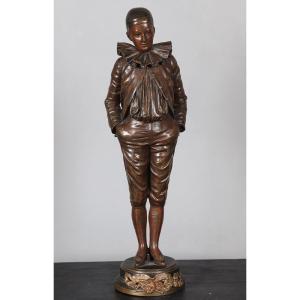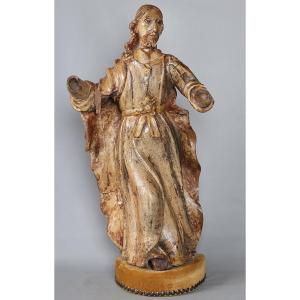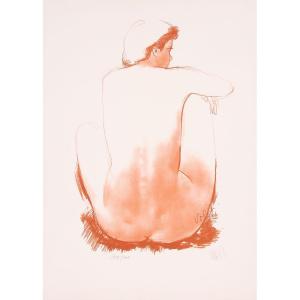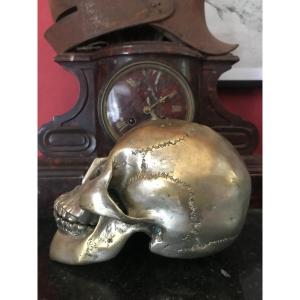Bronze à plusieurs patines, en excellent état, n° 6 / 8
Signé et numéroté sur le socle en bronze, socle qui est aussi une mandoline.
Sujet : Mandoline
Dimensions : hauteur : 78 cm, largeur : 53 cm, profondeur : 40 cm
Biography :
ARMAN 1928 / 2005
Arman or Armand Fernandez, born November 17, 1928 in Nice and died October 22, 2005 in New York, is a French artist, painter, sculptor and visual artist, known for his "accumulations".
He was one of the first to use manufactured objects directly as pictorial material, which represented for him the natural and multiple extensions of the human hand that undergo a continuous cycle of production, consumption, destruction.
The only son of Antonio Fernandez, a furniture and antiques dealer, of Spanish origin who had lived in Algeria, and Marguerite Jacquet, from a family of farmers in the Loire, the young Armand showed an early inclination for drawing and painting.
After his baccalaureate, he studied at the École des arts décoratifs in Nice (now the Villa Arson), then at the École du Louvre. He met Yves Klein and Claude Pascal at the judo school they attended in Nice in 1947. He hired Elena Palumbo Mosca as an au pair to look after his children. With these two friends, he became interested for a time in Eastern philosophies and Rosicrucian theory.
At the end of 1957, Armand, who signed his works with his first name in homage to Van Gogh, decided to abandon the "d" of Armand and made his artist signature official in 1958, on the occasion of an exhibition at Iris Clert.
In October 1960, he held the exhibition "Le Plein" where he filled Iris Clert's gallery with discarded objects and the contents of selected trash cans. This exhibition was the counterpoint to the exhibition "Le Vide" organized two years earlier at the same gallery by his friend Yves Klein.
Also in the same month, under the leadership of art critic Pierre Restany, Arman became, with Yves Klein, one of the founding members of the group of the New Realists (proclaimed by Restany: "new perceptive approaches to reality"), alongside François Dufrêne, Raymond Hains, Martial Raysse, Daniel Spoerri, Jean Tinguely and Jacques Villeglé, joined later by César, Mimmo Rotella, Niki de Saint Phalle, Gerard Deschamps and, in 1963, Christo.
From 1961, Arman developed his career in New York, where he lived and worked half of his time, alternating with his life in Nice until 1967, then in Vence until his death. In New York, he first stayed at the Chelsea Hotel until 1970, then in a loft in the SoHo district and, from 1985, in his building in TriBeCa.
At the end of 1989, Arman received the Legion of Honor from President François Mitterrand.
Three years after his death in New York, part of his ashes were brought back to Paris in 2008 to be buried in the Père-Lachaise cemetery (division 11, a few meters from Frédéric Chopin)
Throughout his life, Arman was also a passionate collector of everyday objects (watches, weapons, pens, etc.) and art objects, particularly traditional African art, of which he was a connoisseur, a valued and recognized specialist.
To create the work Les Revolvers, he used the etching technique.
In 1960, he used plexiglass for the first time.
He is represented by the Templon gallery in Paris and Brussels.
The work :
Arman was interested in the status of the object and the relationship that modern societies have with it, between sacralization and overconsumption-destruction. His works can be classified into different categories.
His "accumulations" of objects following a quantitative logic that erases their singularity reflect an image of profusion, at the same time as they underline the perishable nature of the products of the affluent society.
In the logical continuation of the accumulations, he began in 1959 the series of "Poubelles": he exhibited household waste, rubbish found in the street and waste.
Destruction of objects :
In 1961, he began the series of "Colères": destruction of objects (the "Cups" of violin, piano - like Chopin's Waterloo -, double bass...) glued back on pedestals or wall supports. In "Combustions" (1963), these same objects are burned.
Public commissions :
Arman has invested the public spaces of nearly a hundred cities around the world by carrying out public commissions in the form of monumental works.
1971: Accumulation musicale, a concrete and iron structure, Parco Sempione, Milan5.
1976: Divisionis Mechanica Fossilia6, an accumulation of cogs and metal parts set in concrete, installed at the University of Burgundy in Dijon.
1982: Long Term Parking on the site of the former Fondation Cartier in Jouy-en-Josas, a 19.50 m tower made up of real automobiles stacked on top of each other, cast in concrete.
1984: following a commission from the State, À la République7, an accumulation of 200 marble flags, is installed at the Élysée Palace in Paris.
1984: Contrepoint for cellos, sculpture park, Pierre-Gianadda Foundation, Martigny, Switzerland (purchase, 2003).
1985: in New York, a monumental tower made of bronze cello cups, Rostropovitch's Tower, the same year an accumulation of clocks L'Heure de tous and luggage Consigné à vie were installed at the Gare Saint-Lazare in Paris.
1992: Les Gourmandes accumulation of giant bronze forks in Roanne.
1992: Vénus des Arts cup of a statue with musical instruments, palette and books in bronze installed rue Jacques-Callot in Paris.
1994: work located rue de la Cité (Paris), at the entrance to the police headquarters. Inaugurated by the President of the Republic François Mitterrand.
1995: Espoir de paix an accumulation of real reformed military tanks and tanks, included in a 30-meter concrete pyramid, is made in Beirut.
1999: La Rampante an accumulation of red bronze Ferraris, cut and superimposed, is erected at the entrance to the Imola autodromo Enzo e Dino Ferrari circuit in Italy.
Prints and illustrated books
Arman's engraved and lithographed work is very important. He has produced illustrated books, serigraphs, engravings, lithographs and numerous posters. The very first attempts at engravings by Arman's hand are woodcuts made in 1955, of which the artist has kept no traces. His career as an engraver really began with lithography in 1959 at the Patrick workshop where Corneille and Dubuffet were working at the time. Arman then returned to lithography in 1965 at Pietro Sarto's workshop in Switzerland to create three plates.
From 1965 and his move to New York, Arman began screen printing. He had in mind the screen prints of Jim Dine and Jasper Johns that he discovered in 1962, certainly through his meeting with Andy Warhol.
Illustrated books :
André Verdet, Ritournelle pour Saint-Michel l'Observatoire, 1965
In 1967, he began a collaboration with the Régie Renault as part of a Research Art and Industry initiative by his friend Claude-Louis Renard. He would be the first to benefit from this initiative through which the Régie Renault provided him with technical resources and industrial equipment. He thus produced more than 110 works from 1967 to 1974. See for example Le Murex 10 at the Musée d'Art Moderne in Paris
In 1976, he collaborated on Yannick Bellon's film, Jamais plus toujours, and included several of his objects in it11.
Between 1980 and 1999, the range of works and techniques expanded. Arman declined and multiplied the various execution procedures. At the end of the 1990s, the work became more radical in a succession of gestures related to the object (Accumulations en Relation, Cascades, Sandwiches Combo). He showed a renewed interest in painting (for example in the series Nuits étoilées and émersions).[ref. desired]
A major retrospective took place at the Galerie nationale du Jeu de Paume from January to April 1998, an exhibition that brought together more than one hundred works (from 1959 to 1997). The retrospective then traveled until 2001 to Germany, Portugal, Israel, Brazil, Mexico, Taiwan, Spain, etc.
In 2000, he worked on fragmentations on panels, fragments (drawings and sculptures). He presented a thematic retrospective ("La Traversée des objets"), at the Château de Villeneuve, in Vence.
His bronze sculptures participate in a similar gesture: the artist seizes the icons of Western art (Venus de Milo, Hercules Farnese, etc.), which he cuts up and then welds them back together in a cubist recomposition.
In 2002-2003, Arman returned to easel painting in a series of works, Serious Paintings, which combine the recomposition of musical instruments with their "staging" in painting.
Art market :
Arman's works are collected all over the world.
The Mozart Quintet, a sculpture measuring 153 × 300 × 13.5 cm, was sold on December 7, 2005, at Tajan in Paris for €425,120 (including fees).
Long Term Parking, a sculpture measuring 43.5 × 16 × 16 cm, was sold on October 30, 2006, at Tajan in Paris for €59,200.
Exhibitions:
2010: Arman, Centre Georges Pompidou, Paris, France.
Sold with Invoice and Certificate
Sculpture visible at our gallery in L’Isle sur la Sorgue (France), on weekends.
Free shipping for France.
And on estimate for abroad


































 Le Magazine de PROANTIC
Le Magazine de PROANTIC TRÉSORS Magazine
TRÉSORS Magazine Rivista Artiquariato
Rivista Artiquariato